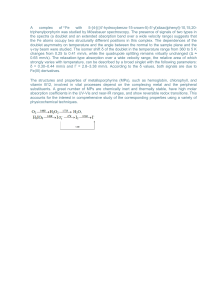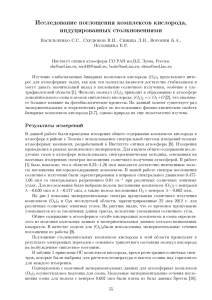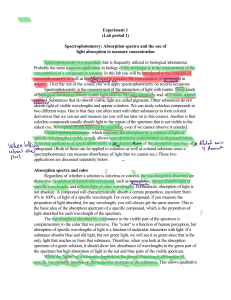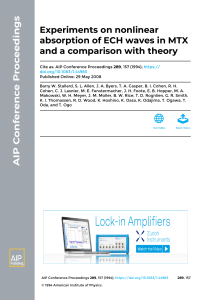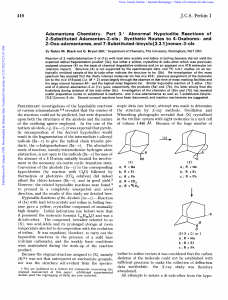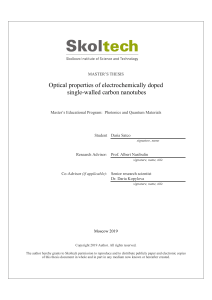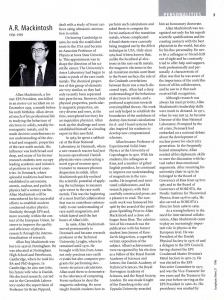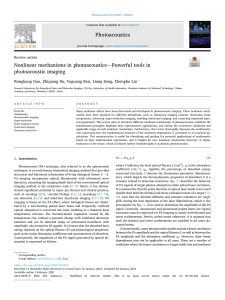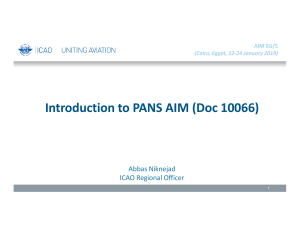mcglynn, External Heavy-Atom Spin-Orbital Coupling Effect. V. Absorption Studies of Triplet States
реклама
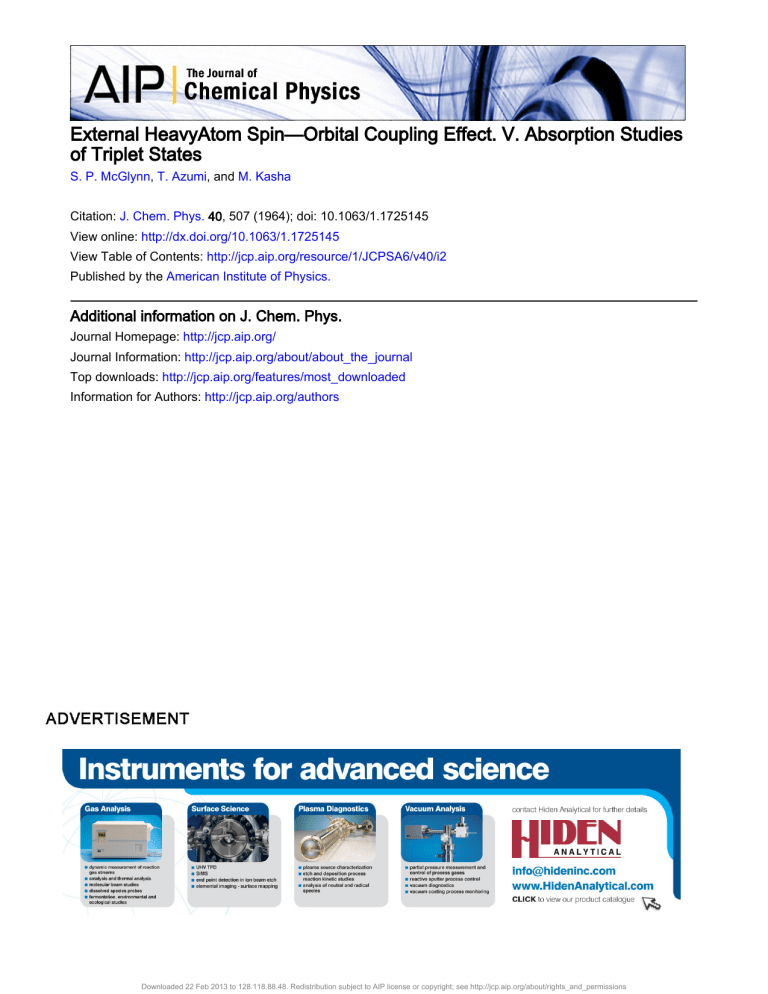
External HeavyAtom Spin—Orbital Coupling Effect. V. Absorption Studies
of Triplet States
S. P. McGlynn, T. Azumi, and M. Kasha
Citation: J. Chem. Phys. 40, 507 (1964); doi: 10.1063/1.1725145
View online: http://dx.doi.org/10.1063/1.1725145
View Table of Contents: http://jcp.aip.org/resource/1/JCPSA6/v40/i2
Published by the American Institute of Physics.
Additional information on J. Chem. Phys.
Journal Homepage: http://jcp.aip.org/
Journal Information: http://jcp.aip.org/about/about_the_journal
Top downloads: http://jcp.aip.org/features/most_downloaded
Information for Authors: http://jcp.aip.org/authors
Downloaded 22 Feb 2013 to 128.118.88.48. Redistribution subject to AIP license or copyright; see http://jcp.aip.org/about/rights_and_permissions
THE JOURNAL OF CHEMICAL PHYSICS
VOLUME 40, NUMBER 2
15 JANUARY 1964
External Heavy-Atom Spin-Orbital Coupling Effect. V. Absorption Studies of Triplet
States *
S. P.
MCGLYNN AND
T. AzUM!
Coates Chemical Laboratories, Louisiana State University, Baton Rouge, Louisiana 70803
AND
M.
KASHA
Department of Chemistry and Institute of Molecular Biophysics, The Florida State University, Tallahassee, Florida 32301
(Received 16 September 1963)
The .lowest energy Tl<'-SO tra~sitions of the molecules chlorobenzene, 1-chloronaphthalene, anthracene,
9, 10-dlbromoanthracene, naphthacene, pyridine, and phenazine have been
Investigated III a varIety of solvents, some of which contain atoms of large atomic number (henceforth
called "heavy atoms:'). It is shown that in heavy-atom solvents an increase of the T,<.-So absorptivity
occurs, and the technIque of external heavy-atom perturbation is demonstrated as a method of conveniently
locat~n~ and validating T,<.-So. ~ransitions. Monitoring experiments in which nonspin-intercombination
transltI?nS, such as S,<.-So tra.nsltIons of the molecule being investigated, and S,<.-So transitions of low-level
contammants have been subjected to external heavy-atom perturbation, have permitted the conclusion
~hat t~e met~lOd is unique !or !'I<'-SO transitions. It is further verified that the external heavy-atom effect
IS a spm-orbltal perturbatIon In nature. Much new data on triplet-state energies and lifetimes has been
obtained and is contained herein.
?, 10-~lchloro:mthrac~ne,
INTRODUCTION
NE of the principal difficulties inherent in the investigation of T1<c-So absorption processes is that
of unambiguously establishing the absorption regions.
Because of the very low molar extinction coefficients
(e= 10-4 to 1), extensive purification of the compound
being investigated is necessary to assure that a suspected T1<c-So absorption band may not be a Sl<C-SO
absorption of some impurity present in very small
(10-3-10-5 %) quantity. It is also essential that one
employ high concentrations of the absorbing species;
however, if considerations of solubility and resolution
are of prime importance, one is forced to use long path
lengths of absorbing material, and to adapt one's instruments accordingly. These difficulties are well illustrated in many of the experiments to be described in
this work.
No absorption technique thus far used has been
entirely satisfactory. The oxygen perturbation method
described by Evans! while providing more significant
enhancement effects than those to be discussed here,
is certainly more cumbersome and is fraught with considerable danger. Nag-Chaudhuri and Basu2 have used
acetylacetonates of copper and iron as "external magnetic perturbers," but the results obtained have been
O
* This work was supported by Research Grants from the U.S.
Atomic Energy Commission (Biology Branch) and from The
National Science Foundation to The Louisiana State University,
and from a contract between The Office of Scientific Research,
U.S. Air Force, and The Florida State University.
1 D. F. Evans, Nature 178, 534 (1956); J. Chern. Soc. (London) 1957, 1351, 3885.
2 J. Nag-Chaudhuri and S. Basu, Trans. Faraday Soc. 54,
1605 (1958).
questioned. 3 It appears from some recent work4 that
ferric acetylacetonate does indeed increase the TI<c-So
oscillator strengths of codissolved aromatics, and that
the effect is associated with the formation of weak
molecular complexes of a charge-transfer nature. It is
implied then that the origin of the ferric acetylacetonate
perturbation is similar, if not identical, to that of the
oxygen perturbation as discussed by Tsubomura and
Mulliken. 5 However, this acetylacetonate effect, while
certainly of considerable interest, is at best minor and
will not be of much importance in establishing the
T1<c-So absorption regions of aromatic donors. In short,
it is still thought that incontrovertible proof of a TI<c-So
absorption requires recourse either to comparisons with
results of emission (phosphorescence) methods or the
study of internally heavy-atom perturbed derivatives
such as has been discussed by McClure,6 or both. It
is expected that the technique of solvent heavy-atom
perturbations, reported here, will make the characterization of T1<c-So absorption regions a more definite
and a less time-consuming task.
Kasha7 reported the first example of a solvent heavyatom perturbation: upon mixing two colorless liquids,
1-chloronaphthalene and ethyl iodide, a yellow color
developed. Spectroscopic examination revealed that the
color was due to an increase in the oscillator strength
of the lowest energy T1<c-So intercombination of 13
4
F. J. Wright, J. Phys. Chern. 65, 381 (1961).
J. Nag-Chaudhuri, L. Stoessell, and S. P. McGlynn, J. Chern.
Phys. 38,2027 (1963).
Ii H. Tsubomura and R. S. Mulliken, J. Am. Chern. Soc. 82,
5966 (1960).
6 D. S. McClure, J. Chern. Phys. 17, 905 (1949).
7 M. Kasha, J. Chern. Phys. 20,71 (1952).
507
Downloaded 22 Feb 2013 to 128.118.88.48. Redistribution subject to AIP license or copyright; see http://jcp.aip.org/about/rights_and_permissions
508
S.
P.
McGLYNN, T.
AZUMI,
chloronaphthalene. It has since been confirmed8 that
this .enhancement is spin-orbital coupling in nature
and IS larger the greater the extent of acid-base interaction between the aromatic donor and the alkyl halide
acceptor. The development9 of low-temperature (77°K)
glass matrices containing alkyl halides has made emission work possible, and it has been shown Io- I2 that
heavy-atom perturbation in a solid matrix results in
an increase of the relative phosphorescence to fluorescence quantum yield (cf>P/cPF) and a decrease of the
phosphorescence lifetime (Tp). Analysis of the emission
data has shown I2 that the process most sensitively
affected by external heavy-atom perturbation is the
radiationless intersystem crossing process from excited
singlet to triplet states. These emission results are
very much the same as those obtained by Robinson13
in which the heavy-atom matrices used were argon,
krypton, and xenon at 4 oK. Finally, it has been
noted 14 that the absorptivity of 1-chloronaphthalene
in ethyl iodide is quite markedly affected by pressure.
It would appear that it is necessary for significant
singlet-ttriplet absorption intensity that a heavy atom
be fairly near to the region of the molecule within
which an electronic transition is localized but, on the
other hand, it is not necessary that the heavy atom
be permanently attached to the molecule undergoing
transition. The transitory perturbation provided by
collision with another molecule, such as a solvent molecule which contains a heavy atom, should be sufficient
to enhance absorptivity, as should any perturbation
which induces even a slight amount of charge transfer
from any of the optically combining states to the
heavy atom solvent or matrix.
The present work is concerned with the study of a
vari:ty of solutes !n various heavy-atom perturbing
medIa. These studIes are not designed to develop a
m:chani~m of the effect being measured, although its
spm-orbital coupling nature will be made evident.
Rather, primary emphasis will be placed on the utilization of absorption spectrophotometry in the detection and characterization of the lowest energy triplet
states of aromatic molecules. It is shown that this
method has significant advantages over those discussed
above, and should prove itself valuable in triplet-state
studies.
8 S. P. McGlynn, R. Sunseri, and N. Christodouleas J. Chern.
Phys. 37,1818 (1962).
'
t See F. Smith, J. Smith, and S. P. McGlynn, Rev. Sci. Instr.
33, 1367 (1962) for an extensive listing.
101. J. Graham-Bryce and J. M. Corkhill Nature 186 965
(1960).
"
11 S. P. McGlynn, G. Daigre, and F. J. Smith, J. Chern Phys
39,675 (1963).
.
.
12 S. P. McGlynn, M. J. Reynolds, G. Daigre, and N. Christodouleas, J. Chern. Phys. 66, 2499 (1962).
13 G. W. Robinson, J. Mol. Spectry. 6, 58 (1961)' see also A
Grabowska, Spectrochim. Acta 19, 307 (1963)'
.
14 W. W. Robertson and R. E. Reynolds,
Chern Phys 29
138 (1958).
.
.,
J:
AND M.
KASHA
TERMINOLOGY
In this paper the term external heavy-atom spinorbital coupling effect is used to describe the spinorbital coupling induced in one molecule by high atomic
number atoms of a second molecule, whether both
mol.ec;ules exist as a stable molecular complex, or as a
coll~slOn pair, or whether they are merely forced, by
lattICe formation, into close proximity to each other.
This effect is considered to be intermolecular in all
cases. When an increase of spin-orbital coupling results from the covalent binding of an atom of high
atomic number to an aromatic system, or from variation of the metallic component of an aromatic metallo
chelate, this will be termed internal heavy-atom spinorbital coupling and will be considered to be intramolecular. When and if an increase of spin-orbital coupling
results from substitution of a skeletal atom, or atoms,
of a 11" system by another atom, or atoms, and as occurs,
for example, in the series benzene, pyrolle, furan, thiophene, selenophene, etc., this will be designated homocyclic heavy-atom spin-orbital coupling. This effect is
deserving of a specific name, if only because many
effects are manifested in this last case which are not
well understood; it is, of course intramolecular.
EXPERIMENTAL
Chemicals
Since an impurity level of 10-6 parts may lead to
significant error, all chemicals used were required to
be extensively purified. Because of the importance of
~his. aspect of the experimental work, a detailed report
IS gIven.
Ethyl iodide. An Eastman-Kodak (EK) "White
Label" grade. It was dried over CaCh and passed
through an alumina column, whereby a reddish-brown
band of iodine was adsorbed tightly at the top of the
column; the eluent was of equal purity to that of Whiting. 7 The liquid was colorless in a 50-cm path. Storage
was effected at O°C, in the dark, and all operations using
this chemical, because of its highly light-sensitive nature, were performed in subdued daylight, to avoid
photochemical complications.
1-Chloronaphthalene. An EK "White Label" product
purified by the method of Whiting. 7
Chlorobenzene. An EK "White Label" grade. It was
purified, after drying over mangesium perchlorate, by
fractional distillation through a 30-in. column packed
with glass helices, at a reflux ratio of 20 to 1 and 0.1 mm
pressure. The fractionation was repeated until constant
optical density was achieved.
Anthracene. EK scintillation grade was dissolved in
petroleum ether and adsorbed on an alumina column
(36 in.X 1t in.). The column was developed with petroleum ether, a very good zonal separation being effected. The lowest broad zone which fluoresced blue
Downloaded 22 Feb 2013 to 128.118.88.48. Redistribution subject to AIP license or copyright; see http://jcp.aip.org/about/rights_and_permissions
EXTERNAL HEAVY-ATOM
Was anthracene. Arranged above this band, and in the
order in which they are named, were narrow strips of
carbazole (light blue fluorescence) and naphthacene
(green fluorescence) adsorbates. Two other bands with
pink fluorescence appeared at the top of the column,
and were probably due to higher polyacenes such as
pentacene, etc. Elution and subsequent spectroscopic
examination of the carbazole and naphthacene bands
showed them to be present at a level of 10-4%. The
anthracene obtained from various chromatographic runs
was then combined and recrystallized from CC4 six
times. The resulting product was chromatographically
homogeneous. All of the operations described were performed in a nitrogen atmosphere to minimize danger
of oxidation.
9,10-dichloroanthracene and 9, lO-dibromoanthracene.
EK "White Label" grades. They were purified by repeated fractional crystallizations from ether.
Ethylene bromide. A Matheson Company product.
It was purified by distillation from mercury, and by
static (H tube) distillation at 0.02-mm pressure and
room temperature.
N aphthacene. This compound is rather susceptible
to oxidation on an alumina column, and all operations
to which it was subjected were done in a nitrogen
atmosphere. The starting material was the EK "White
Label" grade, different lots of which were found to differ
remarkably both in types and degrees of impurities
which they contained. The eluting agent used was a
1% by volume solution of alcohol in petroleum ether.
Use of this agent did not effect a very good separation
of naphthacene and anthracene, but it was quite efficacious in separating out higher polyacenes whose
Sl+--SO absorption spectra interfered in the region to
be investigated (i.e., 6000-12000 A). The chromatogrammed product was finally recrystallized a number
of times.
Phenazine. An EK product. It was fractionally recrystallized a number of times, and finally chromatogramed in an oxygen-free atmosphere.
Pyridine. An EK spectrograde chemical. It was statically distilled once at room temperature. A yellow
residual liquid remained.
Carbon tetrachloride, carbon disulfide, and hexane.
These were cp grades, which were purified by methods
described elsewhere. 16
Techniques
All measurements of optical density were made on
a Beckman DU spectrophotometer. All points on the
included curves, whether they be denoted by circles,
squares, etc., are experimental points, but only such
are shown as are necessary to define a given absorption
band.
15 G. J. Brealey and M. Kasha,
(1955).
J. Am. Chern. Soc. 77, 4462
509
SPIN-ORBITAL COUPLING
Where the solutions used were dilute, the comparison blank was the pure solvent. If the solutions used
were concentrated, such that one could not use the
solvent as a blank, without introducing an error due
to noncompensation for the amount of solvent displaced by the solute, it was found more facile to use
a third liquid of similar refractive index as a blank.
The optical density appropriate to the amount of solvent in the solution, as measured against the same
blank, was then subtracted from that of the solution,
leaving as a residue the optical density of the unperturbed solute plus the increment in same induced by the
perturbing solvent. All solutions of a particular molecule in different solvents were run against the same
blank, so that all absorption curves for anyone molecule have the same base line.
In view of the interpretation of the enhancement of
Tl+--SO transition probability to be given later, the
light absorption of the perturbed molecule is presented
in terms of a molar extinction coefficient, e, evaluated
as follows:
e= (l/el) logloll,
where logloll is the residual optical density mentioned
above, c is the concentration of solute in moles per
liter, and 1 is the absorbing path length in centimeters.
Use of the formula given by Kasha7 leads to a multiplicative increase of error. The abscissas of the figures
are given in wavenumbers (cm- l ) in vacuum. The
aromatic component of all solutions, irrespective of
whether it is the major component of the solution, or
not, is always designated as the solute.
The absorption cells used ranged from 0.1 mm to
20 em in nominal length. With the exception of the
20 em cells, which were of Pyrex and stoppered, and
which had been made to order by Aminco,16 all the
others were stoppered fused silica cells.
Oscillator strengths were evaluated by first drawing
in the SI+--S0 tail, which was obtained in the usual
manner by first extrapolating linearly a plot of loge
vs ii, from shorter wavelengths, where the contribution
of the T 1+--S0 absorption process is assumed negligible.
The area contained between the actual absorption
curve and the exponential tail gives fedii, and was
measured with an Ott planimeter. Tr-~So phosphorescence lifetimes were evaluated by the equation
T=
3.47X lOS (iiA 2n2)-1 (g,./gz) (fedii
rl,
where e is the extinction coefficient in a nonperturbing
medium, iiA, the maximum of the absorption band,
and n is the refractive index of the medium. gu( = 3)
and gl( = 1) are the multiplicities of upper and lower
states, respectively.
16 American Instrument Company, 8030 Georgia Avenue,
Silver Spring, Maryland.
Downloaded 22 Feb 2013 to 128.118.88.48. Redistribution subject to AIP license or copyright; see http://jcp.aip.org/about/rights_and_permissions
510
S. P.
McGLYNN, T. AZUMI, AND M.
1- IN HEXANE, I: I (vjv)
2-IN C<4,I:1 Mv)
:!i-IN ~H..Brz,I:1 (V/V)
KASHA
1 • PURE LIQUID
1'2. (V/V)IN CCI,
3-1'2.(V/V) IN C,H.Sr,
4-1 '2.(V/V) IN C,H5 1
5-1'4(V/V) IN C.HsI
(ALL IN 20 ""' PATH)
~-
oj
~
'"
0
0
d
I/
~
c:.
0
is
0
d
26000
1)0000
54000
WAVENUM8ERS, Vern"'
FIG. 1. The lowest energy T 1<-So absorption spectrum of
chlorobenzene in hexane (Curve 1), in carbon tetrachloride
(Curve 2), and in ethylene bromide (Curve 3), at room temperature (22°C).
25000
22000
19000
WAVENUMBERS
RESULTS
In order to establish that an absorption process being
investigated was indeed a Tl+-SO intercombination,
all, or most of the following criteria were used:
(1) Comparison with the phosphorescence of the
molecule in a rigid glass at nOK, and use of the spectral band mirror-image relationship,
(2) comparison with the absorption spectrum of the
species in a nonperturbing medium, in these cases in
which it was possible to pick up the Tl+-SO absorption
of the unperturbed species,
(3) comparison with the absorption spectrum of intramolecularly perturbed derivatives, and
(4) the correspondence of the lifetime estimated
from the oscillator strength of the species when in a
nonperturbing medium, with that measured by phosphorescence decay means.
FIG. 2. The lowest energy Tl<-SO absorption spectrum of
at room te~perature .(22°C). The. arrows
indicate the ordmate scale to which a partlcular curve IS to be
referred.
1-chloronaphtha~ene
in this region since it itself absorbs too strongly (see
Fig. 8).
The lifetime of the Tl-?SO phosphorescence, calculated as described, is 0.006 sec and is to be compared
with the experimental value l7 of 0.004 sec. PA was
taken as 30950 cm-1 in:the calculation of the phosphorescence lifetime.
The absorption obtained in hexane solution is to be
compared with these for bromobenzene and iodoben-
H;H.r. DECOMPQS£O
<-l,IN C.H..l,f.05x/tr'M.
'"
d
Chlorobenzene
The spectra obtained are shown in Fig. 1. It was
not possible to use ethyl iodide as a perturbing solvent
TABLE 1. Effect of different external perturbers on Tl<-SO
transition of 1-chloronaphthalene. 8
Solvent
[IlJWii] / [IlJWii]eel(
CCI.
350
9.7
97.1
17.5
73.5
Solv
8 The data in this table are of different origin to those in Table II of Ref. 9
of text, and are supplementary to it.
b lsolv is the atomic spin-orbit coupling factor for the heaviest atom in the
particular solvent.
450
550
WlVELENCTli IN m)J.
MO
FIG. 3. The 11;.+->"110+" absorption spectrum of iodine in
ethyl iodide solution (Curve 2), at room temperature (22°C),
and of ethyl iodide which has been decomposed by exposure to
weak sunlight (Curve 1). The arrows indicate the ordinate scale
to which the individual curves are to be referred.
17 M. Kasha, Discussions Faraday Soc. No.9, 14 (1950), quoting D. S. McClure, Ref. 6 of text.
Downloaded 22 Feb 2013 to 128.118.88.48. Redistribution subject to AIP license or copyright; see http://jcp.aip.org/about/rights_and_permissions
EXTERNAL HEAVY-ATOM
SPIN-ORBITAL
zene given by McClure and co-workers. IS The ratio
of the integrated T 1(-So oscillator strengths of chlorobenzene and bromobenzene is 1/25, while the square
of the ratio of the atomic spin-orbit coupling factors
is 1/17.5. This result coupled with McClure and coworkers' result of 1/4.2 for the ratio of the integrated
T 1(-So oscillator strengths of bromobenzene and iodobenzene, the expected ratio being 1/5, seems to point
to the fact that electronegativities have but a small
effect, if any, in the relaxation of spin forbiddenness,
at least in the monohalogenated benzenes. The above
quoted agreement in the case of internal heavy-atom
perturbation leads us to inquire if similar regularities
exist in external perturbations. For this purpose we
have evaluated the increment in optical density in
going from hexane to the other solvents. The ratio of
the increments is
1-IN C~,O.0515m.
and is to be compared with the ratio of the squares of
the spin-orbit coupling factors appropriate to the heaviest atoms in the solvent, which is 17.5. No allowance
is made for the number of heavy atoms contained in
the different solvents, the different concentrations, viscosities, etc. Despite this, it may be said that the
increments in the T 1(-So absorption which occur are
of the correct order of magnitude to be explained on
a spin-orbit coupling enhancement basis.
l-Chloronaphthalene
The results obtained are given in Fig. 2. The ratio
of the increments in oscillator strengths in going from
the pure liquid 1-chloronaphthalene to various perturbing solvents are given in Table 1. The increments
are again of the correct orders of magnitude for a spinorbital coupling effect. The phosphorescence lifetime
calculated is 0.36 sec, while that measured experimentally is 0.23 sec. VA was taken to be 20600 cm-1 in the
calculation of phosphorescence lifetime.
II
14
20
511
COUPLING
I
--- -I~
... ""
15
",," "
/
W4.VENUMBERS, ~xKillcm-1
I
I
I
'/
/
IT
J9
FIG. 5. The lowest energy T,<--SO absorption spectrum of
9,10-dichloroanthracene in carbon disulfide (Curve 1), and in
ethyl iodide (Curve 2) at room temperature. The sharply defined
band at 11 500 cm-1 is a vibrational overtone of 9,10-dichloroanthracene. The broken lines are the extrapolated tail of the
lowest energy S,<--SO absorption band of 9,10-dichloroanthracene.
It was observed that a change in the optical density
of the ethyl iodide solution occurred with time. However, this change coincided with the appearance of a
new band at 4750 A, which is just the spectral position
of the l~a+--+3IIo+u transition of I2 in dilute solution in
ethyl iodide 19 at 20 0 e (see Fig. 3). A further increase
in the optical density sets in below 4000 A and is to
be attributed to molecular complexing of the iodine
(formed by decomposition of the ethyl iodide) with
ethyl iodide20 and 1-chloronaphthalene,21 by which
means charge-transfer absorption processes become
operative. The above interpretation explains the time
19
This value is corroborated by D. E. Schuler and R. H. Schuler,
J. Am. Chern. Soc. 76, 3092 (1954).
FIG. 4. The lowest energy T,<--SO absorption spectrum of
anthracene in carbon disulfide (Curve 2), and in ethyl iodide
(Curve 1), at 22°C. The sharply defined band at 11 500 cm-1 is a
vibrational overtone of anthracene. The dotted lines are the extrapolated tail of the lowest energy S,<--SO absorption band of
anthracene.
18 D. S. McClure, N. W. Blake, and P. L. Hanst,
Phys. 22, 255 (1954).
J. Chern.
20 The calculated position of this charge transfer peak is 2800 A:
S. H. Hastings, J. L. Franklin, J. C. Schiller, and F. A. Matsen,
J. Am. Chern. Soc. 75, 2900 (1953).
21 The N -> E charge transfer absorption for the naphthalene
iodine molecular complex is at 3600 A: N. W. Blake, H. Winston,
and J. A. Patterson, J. Am. Chern. Soc. 73, 4437 (1951). The
N-> E absorption for the l-chloronaphthalene iodine complex
would be expected to lie at somewhat longer wavelengths, because of the lower vertical ionization potential of the chlorinated
derivative.
Downloaded 22 Feb 2013 to 128.118.88.48. Redistribution subject to AIP license or copyright; see http://jcp.aip.org/about/rights_and_permissions
512
S.
P.
McGLYNN, T.
AZUMI,
AND
M.
KASHA
Anthracene and 9,IO-Dihaloanthracenes
IN c,H,1 •aom M.
_..........
'"
~.~.
/
/
/
I
/
/
"/
//
-- - - ---=-'-=-"'-;;..-------------l
'--
2:0
1
IN C5;. ,0.0874 M.
/
/
I
I
/
The results for anthracene, 9, lO-dichloroanthracene
and 9, lO-dibromoanthracene are given in Figs. 4, 5,
and 6, respectively. The peak which in each case occurs at ",11 500 cm- 1 is a vibrational overtone, and
is seen to be but little affected either in position or
intensity, by either internal or external intercombinational perturbations.
Since only two solvents were used throughout this
series of experiments, it is impossible to compare ratios
of enhancements of optical density with the aforementioned ratios of squares of spin-orbit coupling factors.
However, the ratios of the oscillator strengths of the
enhanced absorption in ethyl iodide to that in carbon
disulfide is expected, on the basis of our theory, to be
/
---14000
-
/
/
~
..... .... / / /
0.00091 fA., IN C,H,! Sot.N .
20 cmPATH.
2
FIG. 7. The lowest
energy T 1..... S 0 absorption spectrum of naphthacene in chloroform
(Curve 1), and in ethyl
iodide (Curve 2), at
22°C. The dotted lines
are the extrapolated
tail of the lowest energy
S1 ..... S0 absorption band
of naphthacene.
16000
WAV£NUM&RS
FIG. 6. The lowest energy T1 ..... S o absorption spectrum of 9,10dibromoanthracene in carbon disulfide (Curve 1), and in ethyl
iodide (Curve 2), at 22°C. The sharply defined band at 11500
cm-I is a vibrational overtone of 9,1O-dibromoanthracene. The
dotted lines are the extrapolated tail of the lowest energy SI ..... SO
absorption band of 9,10-dibromoanthracene.
increase of optical density fully and accords with the
observation that the rate of increase is light sensitive.
The increase in optical density which takes place
in CCl4 solution as compared to the pure liquid might
seem somewhat surprising since one l-chloronaphthalene molecule can collision ally perturb others of the
same species. However, considerations of liquid packing, viscosities, number of perturbing CI atoms, and
steric factors do not render the result unexpected.
TABLE II. Effect of external and internal heavy-atom perturbations on lowest energy T1 ..... S o transitions of anthracene and
9,1O-dihaloanthracenes.
Species
[feap
T,
Lr / [feap ls,
secB,b
p(0, 0), cm-
I
Anthracene
9,109,10Dichloro- Dibromoanthraanthracene
cene
1.77
1.64
1. 76
0.09
0.06
0.03
14 820
14 080
14 080
• Calculated from the oscillator strengths of the TI<-So absorptions of the
9 ,1O-dihaloanthracenes in nonperturbing media.
b The effect of 9,lO-disubstitution on lifetime is seen to be quite small. It is
this fact which prompts us to suggest in the text that the magnitudes of external
perturbation should be about the same for all three 9,IO-dihaloanthracenes.
It is shown in Ref. 8 of the text that [f eap] EtI/[f EdP]cs,= (a+fJ)'/a', where
Ol and {3 are descriptive of internal and external perturbations, respectively.
Since a must be roughly constant in this series of molecules, the ratio
(a+~)'/a', which is the ratio of external plus internal effects to internal effect,
must be roughly constant also.
roughly of the same order for both anthracene and its
derivatives. That this is so is readily seen from Table
II. P(0,0) and the lifetimes of the phosphorescent
emissions, as calculated by the previously described
method, are also tabulated in Table II. These values
for the lowest energy (0,0) absorption positions have
been confirmed by subsequent phosphorescence measurements. 22 The limits of the phosphorescence lifetime
of anthracene have been fixed experimentally as lying
between 0.1 and 0.01 sec. 23 The agreement of the value
calculated with these limits is good.
Naphthacene
The lowest triplet level of naphthacene has been
supposed to lie 24 at 18500 cm- 1 and to have a lifetime24
of 2 sec. Both the position and lifetime of this emission
are inconsistent with the smooth correlation23 of the
lowest triplet levels of aromatic hydrocarbons when
one uses the values known22 for the position and lifetime of the lowest anthracene triplet state. Theoretical
22 M. R. Padhye, S. P. McGlynn, and M. Kasha, J. Chern.
Phys. 24, 588 (1956).
23 See discussion by S. P. McGlynn, M. R. Padhye, and M.
Kasha, J. Chern. Phys. 23, 593 (1955).
24 C. Reid, J. Chern. Phys. 20, 1214 (1952).
Downloaded 22 Feb 2013 to 128.118.88.48. Redistribution subject to AIP license or copyright; see http://jcp.aip.org/about/rights_and_permissions
EXTERNAL HEAVY-ATOM
~
PUR£ LIQUID, IZ.?>9Z M.
50CM. ~TH
BlANK: AIR
~
8
..... 0
10
12.:59'zM.
r;j
2
:z
SPIN-ORBITAL COUPLING
513
01202 M.)N HftANE
20CM.~TH
~TH:OIO:3mm.
BlANK:CCL4
BlANK: HEXANE
d
!oJ
~i
80
'Q
r;j
~~
l£.
w
S
Q
r;j
1=0
><
~~
~o
~
r;j
::!;
---------
0
6
I?>
9
15 16
V'IO~(CM-')
o
27
Z5
29
40
FIG. 8. The absorption spectrum of ethyl iodide in the range 8000-45 000 cm-I, at 22°C. This curve defines the useful working ranges
of ethyl iodide as a spectrophotometric perturbing solvent,
calculations25 ,26 on polyacenes have shown that such a
break in correlation is llllreasonable, and a triplet level
at ,......,10 000 cm- I is expected in naphthacene. 25 ,26
From Fig. 7 it is evident that an increase in absorption with onset, and thus also ii(O, 0), at 10 250 cm-I
has occurred. The lifetime calculated from the unperturbed absorption is of the order of 10-2 sec. These
values for both lifetime and the 0,0 vibrational band
position again lead to smooth correlation of the lowest
energy triplet states.
The intensity error in this experiment may amount
to 20%, this estimate being derived from the results
obtained by repeated repetition of the experiment.
Efforts to reduce this error by using reflection type
cells of 50 cm length were unsuccessful since the error,
introduced by the extra operational procedures required, increased more than proportionately to the
advantage obtained from the added path length. Ef. . o.2m.-PH[NAZ1N[ IN Ell
-
14
9
0.04 m.- PHENAZIN[ IN ETH[R
15
16
17
15
19
20
WAVENUMBERS, '1-0"
FIG. 9. The lowest energy T,t-So absorption of phenazine.
- - - at any time in a stable ether solution, - - - - at 1=0,
-,-,-,-. at 1=3 h, -, ,-, ,-., at 1=3 days.
25
26
J. Chern. Phys. 24, 250 (1956).
G. G. Hall, Proc. Roy. Soc. (London) A213, 112 (1952).
R. Pariser,
forts to obtain higher solution concentrations of naphthacene by use of higher temperatures were llllsuccessful due to decomposition of the ethyl iodide at higher
tempera tures.
The two cells used in this experiment were the 20
cm pair already mentioned. They differed in length
only by 1 part in 105• The amount of ethyl iodide
displaced from the solution cell by the naphthacene
was only 1 part in 104• Neither of these factors, whether
they act conjointly or contrarily, can lead to the observed increase in optical density as is evident from
the appended absorption curve for ethyl iodide. (Fig.
8). In view of the latter considerations, and the agreement of both calculated lifetime and spectral position
with expectancy, we accept the existence of the lowest
triplet state in naphthacene to be at 10 250 cm-I •
Nitrogen Heterocyclics
Of these, only two examples have been studied here:
pyridine and phenazine. Reid27 reported that upon dissolving pyridine in ethyl iodide an enhancement occurred with ~=9, and maximum at 28000 cm- I • Investigation of this enhancement shows, however, that
it is due to reaction with formation of ethyl pyridiniul11
iodide. Similar reaction occurred with ethylene bromide
and pyridine. Phenazine reacts with ethyl iodide to
form ethylphenazinium iodide, and the reaction is complicated by a simultaneous decomposition of the ethyl
iodide to form 12, even when in the dark. Fortunately,
the reaction is fairly slow (see Fig. 9). Spectra obtained at different times during the reaction are shown
in Fig. 9. Three peaks are seen to develop upon introduction of phenazine into ethyl iodide, and these peaks
are in very good mirror-image relation to the beautiful
cherry-red phosphorescence with qv......,1 observed by
27 C. Reid, Conference on Molecular Structure and Spectroscopy, Ohio State University, Columbus Ohio, June 1953.
Downloaded 22 Feb 2013 to 128.118.88.48. Redistribution subject to AIP license or copyright; see http://jcp.aip.org/about/rights_and_permissions
514
S.
P.
McGLYNN,
T.
AZU~ll,
TABLE III. Vibrational bands of the lowest energy T1-S O
transition of phenazine.
Tl<-SO
cm-1
in ether,
!J.ii,
cm-1
Tl<-SO
cm-1
in EtI,
T1---->So'
cm-1
in EPA,
!J.ii
cm-1
!J.ii,
cm-1
15 576b
0
15 198
378
AND
M.
KASHA
for phenazine. There seems no doubt then that the
external heavy-atom technique is fully applicable to
nitrogen heterocyclics. Some difficulty is experienced
with reaction which causes product absorption to interfere spectrally; for example, ethylphenazinium iodide
has an absorption maximum at 17200 cm-1• Nonetheless, fast mixing of perturber and aza-aromatic solutions and fast measurement of absorption spectra will
generally provide useful data.
15 000
0
15 600
0
16 200
700
16300
700
17 000
1500
17 000
1400
FI 265b
1301
MONITORING EXPERIMENTS
17 600
2000
13 736
1840
18 300
2700
12 8871>
2689
18 900
3300
In order that the external heavy-atom effect be considered characteristic of triplet states, it is necessary
to investigate the effects exerted by such perturbation
on vibrational overtones and on SI+-S0 absorptions;
it is also necessary to investigate the ability of such
18 300
2800
19 500
4000
a From R. W. Harrell, Ref. 29 of text.
b The three strong bands observed by Lewis and Kasha, Ref. 28 of text; the
spertrallocations specified here are from Ref. 29 of text.
...
:g
d
z;
Lewis and Kasha28 for phenazine. It is consequently
tempting to attribute these three peaks to the 11", 11"*
transition 3B 2u+-lA g of phenazine. That this is appropriate is further evidenced by the fact that the lifetime
of the phosphorescence is observed29 to be 0.023 sec,
and is calculated from the absorption in ethyl ether
to be 0.045 sec. The value calculated in ethyl iodide
solution at zero time is O.OlO sec. Further vindication
of the attitudes displayed here are contained in Table
III, where the vibrational peaks observed in absorption are matched with those found in the phosphorescence by Harrel1. 29
The heavy-atom effect on the lowest T 1+-S absorption of acridine has also been investigated by Harrell,29
with results fully comparable to those reported above
TABLE IV. Results of monitoring experiments.
Vibrational
overtone
lLa<-lA
Transition
11 360 0.0095
26 640"
26 308
332
9,10-Dichloroanthracene
11 420 0.0092
b
24 684
246
9,10-Dibromoanthracene
11 490
Anthracene
Naphthacene
24 930
24 563
0.0088
21 225 b
20 990
~:g
Fd
li1
b~
~
;;jl:
::."
d
20
21
II
2'
ZO
WAVENUNBERS, "'0"
21
II
W
FIG. 10. The absorption spectrum of anthracene, and of anthracene with a known added contamination of naphthacene in the
region 20000-24000 cm-1 at 22°C. Curve 1, 0.062M-anthracene
in ethyl iodide; Curve 2, 0.062M-anthracene containing an added
3.14XI0-4% contamination of naphthacene, in ethyl iodide;
Curve 3, 0.0840M-anthracene, in carbon disulfide; Curve 4,
0.0840M-anthracene containing an added 6.82X 10-4% contamination of naphthacene, in carbon disulfide. The dotted lines
are the extrapolated tail of the lowest energy Sl<-SO absorption
band of anthracene for Curves 1 and 3 only.
Vibrational Overtones
ii(O, 0)
cm-1
Alcohol
Compound
~
u
SOlVENT CSa
perturbation to discriminate weak impurity SI+-S0
transitions. Such experiments are reported below.
ii(O, 0)
cm-1
Ethyl
iodide
ii
cm-1
~g
1::0
sO!.V£NT ;C,H,1
235
In Figs. 4, 5, and 6 are shown the vibrational overtone C",,11200 cm-1 ) of anthracene, 9, lO-dichloroanthracene and 9, 10-dibromoanthracene, respectively;
their wavenumbers and intensities are tabulated in
Table IV. Each of these vibrational overtones was
investigated in carbon disulfide and in ethyl iodide
solution. In no case was there any detectable difference found, in either solvent, as regards molar extinction coefficients or spectral locations of the overtones.
S I+-S0 Absorption Bands
• R. N. Jones, Chern. Rev. 41,353 (1947).
bE. Clar and Ch. Marschalk, Bull. Soc. Chim. France 17,434 (1950).
28 G. N. Lewis and M. Kasha, J. Am. Chem. Soc. 66, 2100
(1944).
29 R. W. Harrell, Ph.D. dissertation, The Florida State University, January 1959.
1
The lLa+- A transitions in anthracene, 9, 10-dichloroanthracene and 9,10-dibromoanthracene were measured in ethyl iodide solution, using ethyl iodide as a
comparison blank in the region 4300 A-33oo A. In
no case was there any difference in molar extinction
Downloaded 22 Feb 2013 to 128.118.88.48. Redistribution subject to AIP license or copyright; see http://jcp.aip.org/about/rights_and_permissions
EXTERNAL HEAVY-ATOM
SPIN-ORBITAL COUPLING
for a T2~SO transition (to the second triplet of anthracene). The oscillator strengths of these bands were
detectably the same in both CS 2 and.in ethyl iodide
solution, as would be expected if the heavy-atom effect
were discriminatory. The results of these experiments,
as well as the further absorption work necessary to
verify that these bands were indeed due to naphthacene
impurity are diagrammed in Fig. 10. It is concluded
that the method of external perturbation affords a
means of uniquely distinguishing between low-level
impurity SI~SO transitions and Tl~SO absorptions
proper to the compound being investigated.
coefficient noted. There was, however, in each case, a
red shift in going from alcohol to ethyl iodide as solvent. These are also tabulated in Table IV.
Impurity SI~SO Transitions
A sample of unchromatogrammed anthracene was
investigated, and as expected, two weak absorption
maxima whose extinction corresponded to 10--4 % naphthacene impurity were located on the rising tail of the
SI~SO absorption of anthracene. These maxima were
at 20990 and 22460 cm-1, respectively, and were of
such intensity that they could very well be mistaken
THE JOURNAL OF CHEMICAL PHYSICS
515
VOLUME 40, NUMBER 2
15 JANUARY 1964
Hole Mobility in Organic Molecular Crystals
R.
RAMAN* AND
S. P.
MCGLYNN
Coates Chemical Laboratories, Louisiana State University, Baton Rouge, Louisiana 70803
(Received 4 June 1963)
Adoption of a simple crystal counter technique has made possible a study of carrier mobilities in organic
molecular crystals. The results give a mean value of 0.48 cm'lV -sec for the mobility of holes in anthracene
in the low-field region. The data indicate that study of pulse rise times at high electric field strengths will
provide information on charge-carrier scattering mechanisms in these materials.
INTRODUCTION
HE basic difficulties which limit understanding of
the mechanism of photoconduction in organic
molecular crystals are electrode-crystal contact and
barrier effects, development of space-charge regions in
the crystal, and production of secondary photo and
electrical effects; all of these are inherent in normal dc
or ac photo current measurements. In common practice
it is hoped to avert these difficulties by the use of pulse
techniques. Even here there exist a few variations:
pulsed illumination of a crystal having a dc bias voltage,
synchronized pulse illumination and pulsed voltage
onto a crystal, superimposition of pulsed voltage on a
crystal having dc bias voltage, etc. However, most work
on organics has been confined to thick crystals which
required excitation by very-high-intensity light flashes
while under the influence of an arbitrary electric field.
Secondly, considerable difficulty is experienced in
achieving the bandwidth and signal-to-noise ratio required for observation of true characteristics. The
present work has been done with a view to obtain
optimum experimental conditions for the study of thin
crystals (10-100 J.I.) using low-intensity light pulses.
T
,. Post Doctoral Research Fellow supported by contract between U.S. Atomic Energy Commission-Biology Branch and
The Louisiana State University.
Secondary photoeffects may thus be minimized and
materials which may only be grown as large single
crystals with considerable effort may be studied with
ease in the form of thin layers.
In the pulse measurements to be described the
crystal acts essentially as a counter and almost all the
secondary effects, such as space charge, etc., may be
minimized by using thin crystals, high fields, and low
intensity of illumination. The theory of operation of
the crystal counter has been thoroughly discussed by
Yamakawa,1 Brown,2 Van Heerden,3 Williams,4 and
Hartke.s The crystal forms the dielectric of a capacitor
subject to an arbitrary electric field, and current pulses
are produced when either of the electrodes are bombarded with photon or particle radiation. The time required for the generated charge pulse to rise to its
maximum value in a field sufficiently large to ensure
that the range of the carriers is larger than the electrode
separation is then measured. Under these conditions,
Qt= (noeJ.l.E/d) t,
(1)
where Qt is the charge induced at time t, no the number
1 K. A. Yamakawa, Phys. Rev. 82,522 (1951).
'F. C. Brown, Phys. Rev. 97, 355 (1955).
3 P. J. van Heerden, Phys. Rev. 106; 468 (1957).
4 R. L. Williams, Can. J. Phys. 35, 134 (1957).
5 J. L. Hartke, Phys. Rev. 125, 1177 (1962).
Downloaded 22 Feb 2013 to 128.118.88.48. Redistribution subject to AIP license or copyright; see http://jcp.aip.org/about/rights_and_permissions
